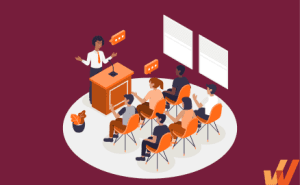Gamification in Corporate Training in 2024 (+Benefits, Examples)
- Published:
- Modified: April 8, 2024

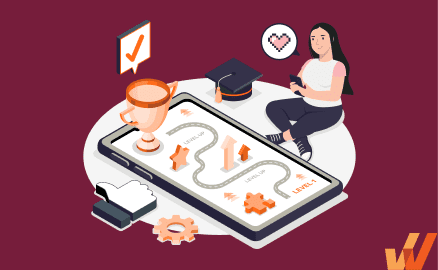
Harvard Business School conducted a recent study with KPMG’s workforce across 24 offices that participated in training across 29 months, analyzing the impact of gamification on training effectiveness.
It measured gamification’s impact by looking at multiple factors that fell across one of two categories: 1)if it increased core KPMG business outcomes and 2)overall employee engagement with the training.
The research found that gamified training experiences led to:
- An uplift in core KPMG business outcomes for offices that had higher levels of participation, including a 25% increase in fee collection, a 22% increase in new opportunities, and a 16% increase in clients.
- Offices with buy-in and participation from leaders had higher overall employee participation in the training program and had higher growth in business outcomes.
- Higher overall job performance from employees who engaged with its Globerunner training program.
In this article, we’ll discuss the concept of training gamification, the key elements of gamification, why it works at a psychological level, its impact on corporate L&D, and best practices and tools for integrating elements of gamification into your corporate training strategy that drives employee performance and business outcomes.
What Is Gamification In Corporate Training?
Gamification in corporate training is an innovative approach that incorporates game design elements and principles into training programs to enhance engagement, motivation, and learning retention for employees. By introducing gamification elements such as points, badges, leaderboards, challenges, and rewards, gamification transforms traditional learning experiences into an engaging, interactive, and competitive activity. This training method leverages the psychological principles of reward-based learning, encouraging participation and making acquiring new skills and knowledge more engaging.
Key Features of Gamification for Employee Training
Here are some specific elements of a gamification framework.
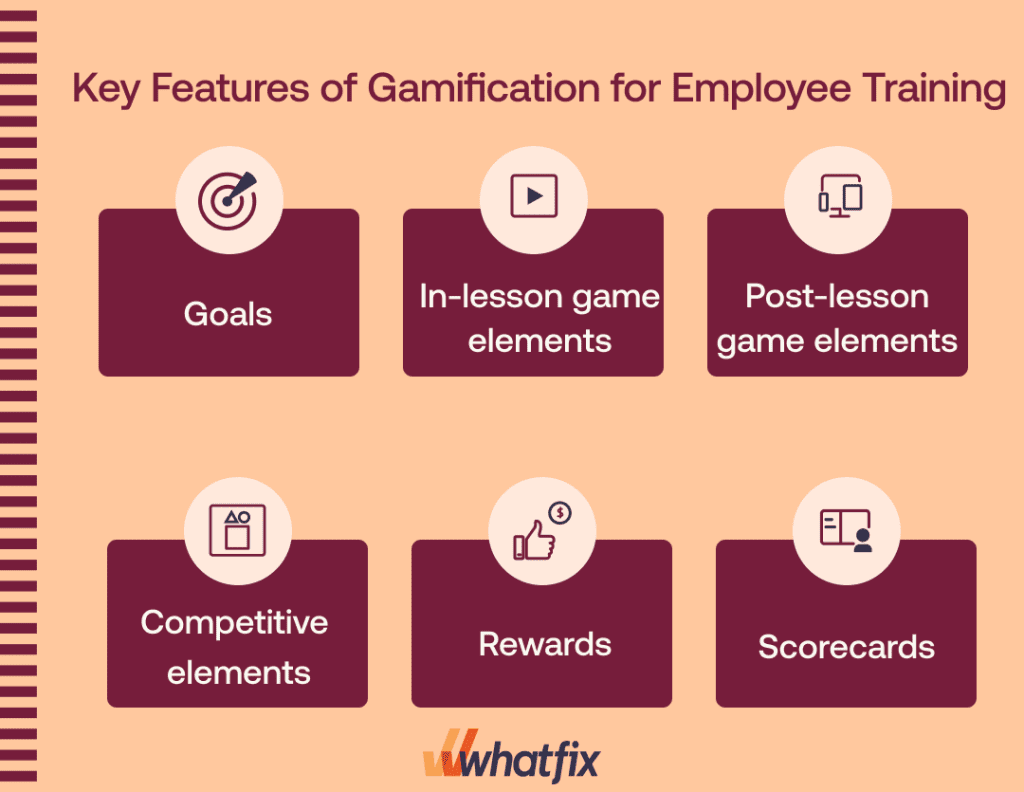
1. Goals
All workplace training efforts need to be goal-oriented, and gamified training needs to be built around getting employees to reach those goals. Whether the goals are related to performing certain tasks or achieving the next level of subject matter expertise, they should be clear to learners from the first lesson.
Create SMART goals (specific, measurable, achievable, relevant, and time-bound) to define the parameters that ensure the objectives are attainable within a specific time frame. This approach eliminates generalities and guesswork, assigns a clear timeline, and sets employees up for success. Defining SMART goals makes it easier for managers to track the progress of their employees while completing the goals.
2. In-lesson game elements
There are many areas to incorporate game elements throughout the learning process, many of which are in-lesson. Things like brief checkpoint quizzes within a narrative lesson, interactive roleplaying scenarios, or even vocabulary flashcard games can be part of the in-lesson gamification.
3. Post-lesson game elements
Game elements can also be applied post-lesson in the form of cumulative knowledge quizzes or recall of earlier lessons. Developing quizzes reinforces newly learned knowledge and ensures maximum learning retention.
4. Competitive elements
Incorporating points, badges, and leaderboards allow for friendly competition and motivates learners to complete training activities to the best of their abilities.
5. Rewards
While competitive elements like points and badges make training more engaging, they don’t always work as the only source of motivation. It can be helpful to offer more tangible rewards when learners reach certain milestones as well. Rewards provide employees with incentives to complete lessons and boost engagement.
6. Scorecards
Scorecards are progress summaries that display details about the performance of individual learners. They can be customized to include several stats, including the learner’s name and profile photo or avatar, total experience points and badges collected, leaderboard standings, and leveling progress. This tool can be used by the L&D team and learners to monitor pain points and compare success without digging into the data.
Why Does Gamification Training Work?
The effectiveness of gamification in corporate training can be attributed to several psychological principles that drive human behavior and learning:
1. Reward system activation
Gamification triggers the brain’s reward system by offering rewards (such as points, badges, or levels) for completing tasks or achieving goals. This reward mechanism stimulates the release of dopamine, a neurotransmitter associated with pleasure and motivation. When employees receive these rewards, they experience a sense of achievement and satisfaction, which encourages continued participation and engagement in the training process.
2. Goal-oriented behavior
Gamification structures learning around clear, attainable goals. Setting and achieving these goals is inherently motivating for most people. When employees have specific objectives to strive for, they are more focused and driven. This goal-oriented approach aligns well with the natural human tendency to seek and achieve objectives, thereby improving engagement and the effectiveness of the training.
3. Competitive drive
Many individuals are naturally competitive, and gamification taps into this by incorporating elements like leaderboards and scoring systems. This healthy competition among peers can motivate employees to engage more deeply with the training content, striving not only to learn but also to excel. It harnesses the social aspect of competition, spurring individuals to improve their performance.
4. Real-time feedback loops and progress tracking
Gamification provides immediate feedback on learners’ actions, essential for effective learning and skill development. This real-time feedback allows employees to understand their strengths and areas for improvement, adjust their strategies, and see the impact of their efforts immediately. Progress tracking, often visualized through progress bars or levels, helps learners see how far they’ve come and how close they are to achieving their goals, further motivating them.
5. Sense of autonomy and control
Gamification often gives learners choices and control over their learning journey. When employees feel they have control over their learning process, their intrinsic motivation increases, leading to more engagement and a deeper commitment to learning.
6. Social learning and collaboration
Many gamification strategies encourage collaboration and social interaction, aligning with the social learning theory, which states that people learn from one another. Through collaborative challenges, group tasks, or sharing achievements, gamification fosters community and collaboration. This not only makes learning more enjoyable but also promotes knowledge sharing and team building.
The Effects of Gamification in Workplace Training
Here are a few benefits of integrating a gamification approach to workplace training.
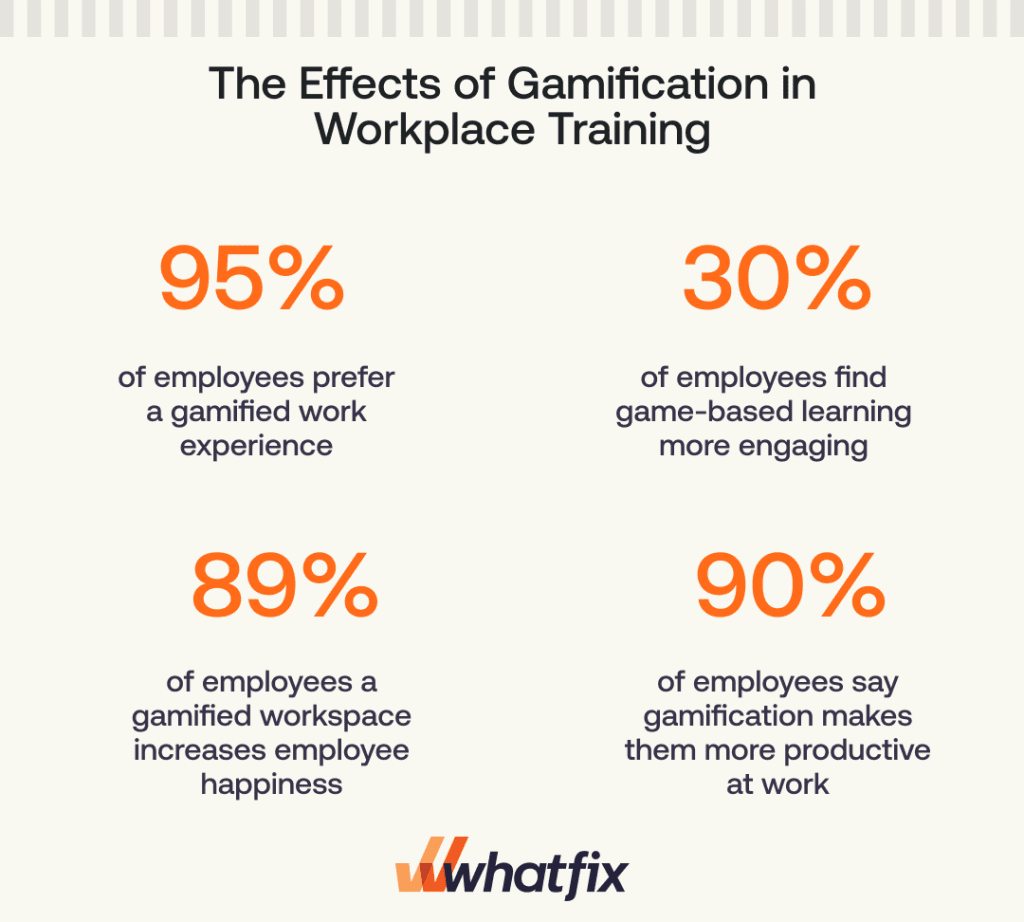
1. Increased engagement and productivity
The reward system in gamification training makes employees enjoy the process of learning, hence, they are more likely to retain information and keep up with lessons. Just like in other areas of work, increased engagement is tied to productivity and overall enjoyment of employee experience.
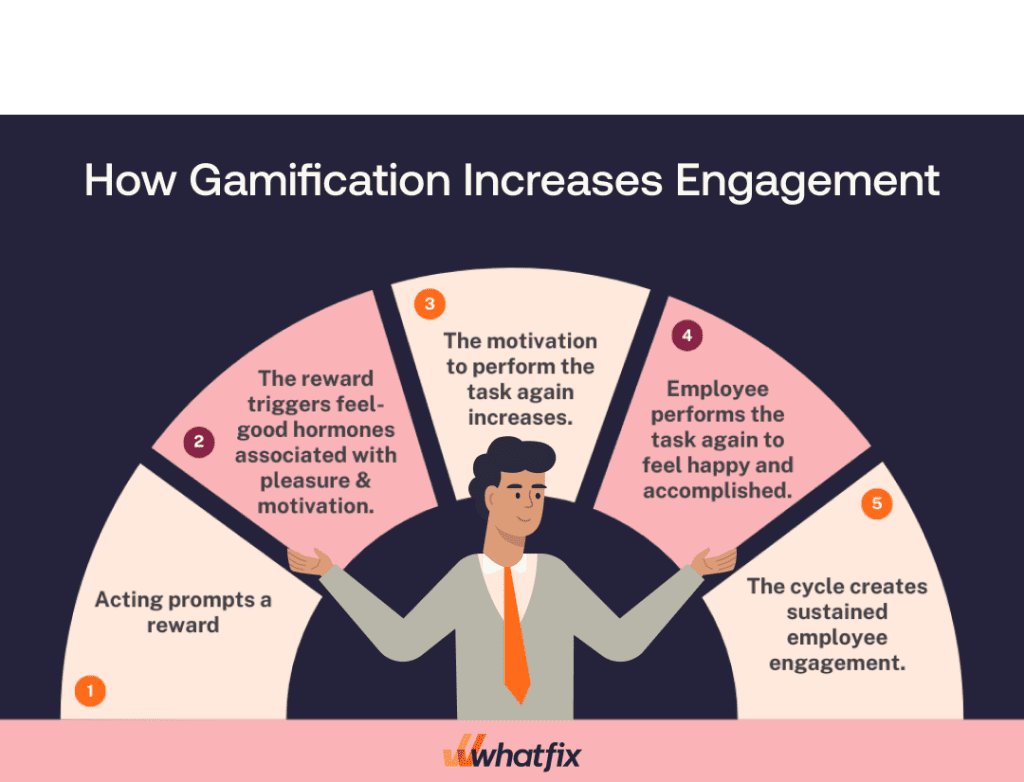
2. Encourages social interaction and teamwork
With gamification, training becomes a vehicle for social interaction and team bonding. It incorporates a bit of healthy competition into the training program and keeps learners eager to make progress. When employees are grouped by their department and progress is measured as a unit, they are motivated to demonstrate the aptitude of their team and work together to come out on top.
3. Fosters creativity and innovation
Game elements aren’t restricted to quizzes and memory puzzles, they can be designed to foster creative approaches to challenging situations. For instance, open-ended questions can be incorporated into role-playing scenarios, and responses can be discussed as a group. Or, groups of learners can be assigned a particular problem to be solved together. There isn’t always one right answer when it comes to gamification in training.
4. Improves training results
As it has become more commonly used in the workplace, gamified training has been shown to improve outcomes such as learning retention, workplace productivity, and overall employee experience. With these factors being the ultimate goal of most workplace training, it’s clear that gamification is a great way to maximize the efficiency of training efforts.
5. Enables shorter feedback cycles
In game design, feedback loops take the result of a given action and use it as input into the same process, making the player feel accomplished and motivated to keep going. In a gamified training context, feedback cycles let learners build on their success to reach goals quickly.
When to Use Gamification in Corporate Training
Gamification can be effectively applied in various areas of corporate training, enhancing engagement and retention.
1. Employee onboarding
Gamification can make the employee onboarding process more engaging for new hires. By incorporating elements like quests or challenges that new employees complete as they learn about the company culture, policies, and roles, the process becomes interactive and fun.
This approach helps accelerate the integration of new employees into the company, making them feel welcomed and connected from the start, while also ensuring they absorb essential information effectively.
2. Compliance training
Traditionally seen as tedious, compliance training can be gamified to increase engagement. Incorporating scenarios where employees earn points or badges for correctly navigating legal and ethical dilemmas can make learning about compliance more interactive and memorable.
Gamification in compliance training ensures better retention of important regulations and policies, thereby reducing the risk of compliance breaches.
3. Upskilling
For ongoing skill development, gamification can be used to create a series of levels or milestones that employees reach as they acquire new skills. This can include earning certifications or badges upon completing training modules or achieving high scores in skill assessments.
Gamified upskilling motivates employees to continuously learn and grow, fostering a culture of continuous professional development.

4. Product knowledge training
In product knowledge training, gamification can involve creating simulations or quizzes where employees earn points for correctly answering questions about the product features, uses, and benefits.
This approach helps employees to deeply understand the product, which is crucial for quality customer service and effective sales strategies.
5. Sales training
Gamification in sales training can involve competition-based elements such as leaderboards or sales simulations where employees practice and refine their sales techniques to achieve higher scores or rewards.
It not only enhances the sales skills but also injects a spirit of healthy competition among the sales team, driving them to improve their performance.
Best Practices for Integrating Gamification into Your Corporate Training
Integrating gamification into corporate training can be a highly effective strategy to enhance engagement and learning outcomes. Here are a few best practices to follow to implement it successfully.
1. Identify learning objectives and understand your audience
Before integrating gamification, clearly identify the learning objectives. What skills or knowledge should the training impart? Understanding these goals ensures that gamification elements reinforce rather than distract from the learning content.
You can implement a SMART goals framework that creates goals based on five criteria areas (specific, measurable, achievable, relevant, and time-bound), enabling employees to achieve personal goals and OKRs based on clearly defined objectives.
Knowing your audience is equally crucial. Different groups may have varying preferences and learning styles. Tailor your gamification strategy to suit the demographics, professional backgrounds, and learning preferences of your employees. This ensures maximum engagement and effectiveness.
2. Insert gamification into existing training programs
Enhance existing training programs with gamification elements such as progress trackers, interactive scenarios, and quizzes.
Progress trackers give learners a visual representation of their advancement, boosting motivation. Interactive elements such as simulations or decision-making scenarios make learning more engaging and practical. Quizzes, especially when timed or scored, add an element of challenge and help improve learning retention.
3. Develop multiple, role-based learning challenges, levels, and paths
Create role-specific gamified challenges to ensure relevance and engagement in employee training. Different roles might require different skill sets, and gamification must reflect this diversity.
Incorporating multiple levels or paths in the training allows learners to progress at their own pace and choose paths relevant to their roles and interests. This approach caters to varying levels of expertise, making training inclusive for all proficiency levels.
4. Clearly explain the goals and offer enticing rewards
Communicate the objectives of the training experiences and how it aligns with broader professional or organizational goals. This clarity helps foster a deeper understanding of the training’s value and motivates employees to participate.
Furthermore, offer rewards that are enticing and meaningful. These rewards could range from digital badges and certificates to tangible benefits like gift vouchers or extra leaves. Ensure that the rewards are aligned with the achievements they represent.
5. Allow for social interaction
Encouraging social interaction within the training program improves engagement. Social interactions can be facilitated through group challenges, discussion forums, or collaborative tasks. This approach not only makes learning more enjoyable but also promotes knowledge sharing and team building, enhancing the overall learning experience for your employees.
6. Use friendly competition
Introduce elements such as points, badges, and leaderboards to foster a sense of competition amongst your employees. This friendly competition motivates employees to participate and engage more actively with the training.
Ensure that the competition remains healthy and inclusive. Recognize various achievements to cater to strengths and contributions, not just the top performers.
7. Measure the success of your training gamification with data
Use analytics to measure the success of your gamified training. Track engagement levels, progress through modules, quiz scores, and feedback. This data can help the L&D teams understand what’s working in the training and what’s not, allowing for timely adjustments and improvements. For L&D leaders skeptical about implementing gamification in training for their organization, this data will provide insight into if it can be continued in the future.
8. Make it fun
Last but not least, ensure that the gamification elements are fun. The primary goal of gamification is to make learning enjoyable, so the design must be engaging and entertaining.
Fun elements can include humorous content, visually appealing graphics, and creative storytelling. The idea is to create an enjoyable learning experience employees enjoy and look forward to.
5 Tools to Gamify Corporate Training & Development

1. EdApp
- G2 Rating: 4.7
- Pricing: Starting at $0.00
EdApp is a mobile-first microlearning platform designed for corporate training. It offers features such as interactive lessons, gamified quizzes, and spaced repetition, making learning engaging and effective. Aside from the gamification features, EdApp has several microlearning templates that you can incorporate when creating courses.

2. Gametize
- G2 Rating: 4.5
- Pricing: Starting at $0.00 – $500 a month
Gametize is an enterprise-grade L&D tool that specializes in creating gamified experiences for learning and engagement. The platform allows you to design gamified content by choosing from a vast library of game templates, which are divided into project categories like employee engagement, learning and development, talent acquisition, etc. You can also boost training engagement and completion rates using flashcards, quizzes, and interactive challenges. It is an excellent solution that fosters a sense of community and achievement in corporate training programs.

3. Edgagement
- G2 Rating: NA
- Pricing: Not available online
Edgagement is a training gamification tool that uses a simple drag-and-drop feature to help you build gamified microlearning courses, quizzes, and surveys for your teams. you can create engaging training materials with little to no knowledge of graphic design by using over 15 game templates. This platform uses interactive content, like quizzes and polls, to enhance learning and participation. It’s suitable for organizations looking to make their training more dynamic and interactive.
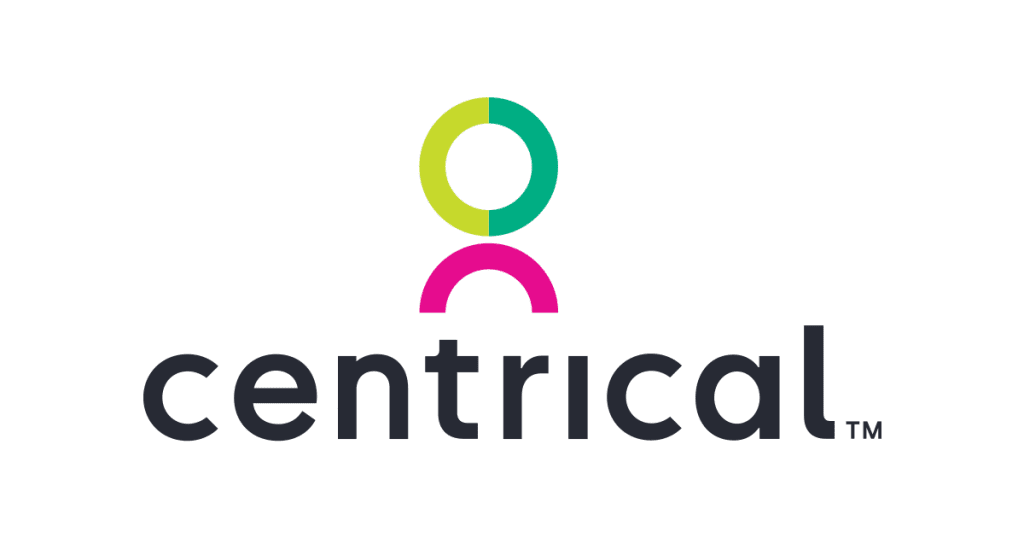
4. Centrical
- G2 Rating: 4.6
- Pricing: Not available online
Centrical is a gamification training software has an intuitive user interface that allows you to create polished game-based learning materials without needing advanced technical design skills. You can customize learning challenges, set reward-winning competitions, or design quest-based game narratives to help your employees practice skills and improve their overall knowledge and skills. The platform integrates advanced gamification, microlearning, and real-time performance management. It’s ideal for organizations aligning training with performance goals and business outcomes.

5. Qstream
- G2 Rating: 4.6
- Pricing: Not available online
Qstream is designed to reinforce training through scenario-based quizzes and challenges. This platform uses spaced repetition and analytics to improve knowledge retention and identify areas where learners need more support. Managers can determine training efficacy, address knowledge gaps, and track overall employee performance in real-time with functional tool components like proficiency heatmaps, leaderboards, team comparisons, and analytics dashboards.
Real-Life Successful Gamification Examples in Organizations
In the past decade, businesses across almost every industry have incorporated gamification principles into employee training. This has provided abundant evidence suggesting that gamification provides a versatile framework that can be incorporated into existing workplace training or used to build out new L&D initiatives.
Deloitte Leadership Academy
Deloitte is a prominent international professional services network that provides various services like consulting, auditing, and risk advisory to its clients around the world. In 2008, the Deloitte Leadership Academy (DLA) was established as an online internal training program. DLA used gamification principles to boost engagement and regular participation by 37% by early 2013. Achievements were shareable on sites like LinkedIn, incentivizing participation by boosting the public reputation of individual employees. In 2011, Deloitte established what is now called Deloitte University, which serves as its real-life hub for employee learning, development, networking, and well-being.
Cisco
Digital communications technology company, Cisco, uses gamification to train its employees to become social media experts. Its social media training program provides several levels of certification, including a number of sub-specializations specific to different job functions. Cisco’s L&D program includes team challenges that promote collaborative training, exploration of social media topics, and progression loops that guide learners along the path to mastery of social media skills. This program has been hugely successful, equipping Cisco employees with the knowledge they need to use social media effectively in a professional context.
McDonald’s Japan
New associates at McDonald’s Japan are trained in their work duties, flipping burgers and even frying fries, via a specially designed Nintendo game. New hires complete these training games at home, so they could focus on other necessary skills when they clocked into work. This is a great example of innovative gamification that saved McDonald’s plenty of time and money.
Whatfix empowers L&D and IT teams with a no-code digital adoption platform and end-user behavior analytics to enable employees with in-app guidance and moment-of-need support.
This revolutionizes employee training by providing a highly contextual, engaging, and role-specific learning experience for different end-users. By tailoring training to individual roles, Whatfix ensures that each employee receives relevant and practical knowledge, directly applicable to daily tasks. This role-based approach, combined with interactive in-app guidance, transforms learning and development into an engaging experience, far removed from traditional, one-size-fits-all training methods.

Furthermore, integrating reinforcement learning within the workflow enables continuous skill development and knowledge retention without disrupting the natural workflow. Whatfix’s innovative platform not only streamlines the learning process but also embeds it seamlessly into the workplace environment, resulting in a more skilled workforce equipped to meet the evolving demands of the modern workplace.
With Whatfix’s User Actions, track end-user behavior and custom events to understand how end-users are engaging with your digital workflows and to identify where friction is happening. This guides organizations on how to improve digital processes and application experiences, as well as identifies where new in-app guidance and support should be leveraged.
Get started by requesting a Whatfix demo today!
Thank you for subscribing!
